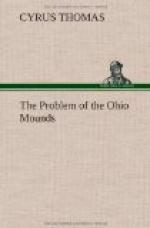Now it so happens that a considerable number of shell gorgets have been found in the mounds of western North Carolina and east Tennessee, agreeing so closely with those brief descriptions, as may be seen the figures of some of them given here (see Figs. 2 and 3), as to leave no doubt that they belong to the same type as those alluded to by the writers whose words have just been quoted. Some of them were found in the North Carolina mound from which the iron articles were obtained and in connection with these articles. Some of these shells were smooth and without any devices engraved upon them, but with holes for inserting the strings by which they were to be held in position; others were engraved with figures, which, as will be seen by reference to the cuts referred to, might readily be taken for stars and half-moons, and one among the number with a cross engraved upon it.
The evidence that these relics were the work of Indians found in possession of the country at the time of its discovery by Europeans, is therefore too strong to be put aside by mere conjectures or inferences. If they were the work of Indians, they must have been used by the Cherokees and buried with their dead. It is true that some of the engraved figures present a puzzling problem in the fact that they bear unmistakable evidences of pertaining to Mexican and Central American types, but no explanation of this which contradicts the preceding evidences that these shells had been in the hands of Indians can be accepted.
[Fig. 3: Shell gorget with engraving of coiled serpent]
In these mounds were also found a large number of nicely carved soapstone pipes, usually with the stem made in connection with the bowl, though some were without this addition, consisting only of the bowl with a hole for inserting a cane or wooden stem. While some, as will hereafter be shown, closely resemble one of the ancient Ohio types, others are precisely of the form common a few years back, and some of them have the remains of burnt tobacco yet clinging to them.
Adair, in his “History of the North American Indians,” [Footnote: P. 433.] says:
“They mate beautiful stone pipes and the Cherokees the best of any of the Indians, for their mountainous country contain many different sorts and colors of soils proper for such uses. They easily form them with their tomahawks and afterwards finish them in any desired form with their knives, the pipes being of a very soft quality till they are smoked with and used with the fire, when they become quite hard. They are often full a span long and the bowls are about half as large again as our English pipes. The fore part of each commonly runs out with a sharp peak 2 or 3 fingers broad and a quarter of an inch thick.”
Not only were pipes made of soapstone found in these mounds, but two or three were found precisely of the form mentioned by Adair, with the fore part running out in front of the bowl (see Fig. 5, p. 39).




